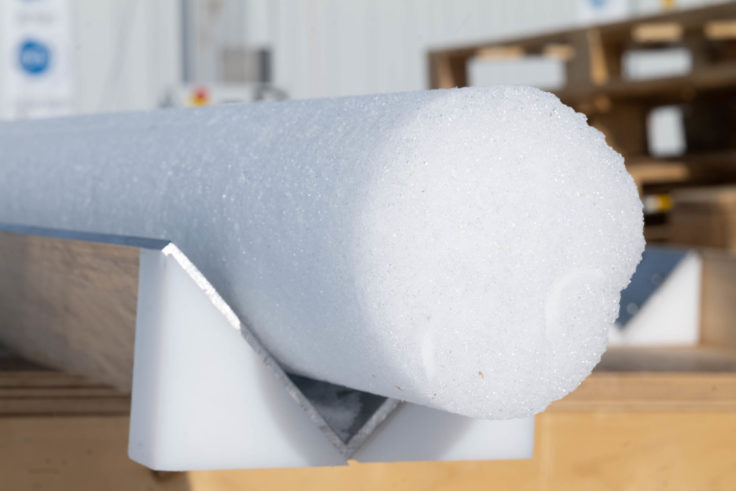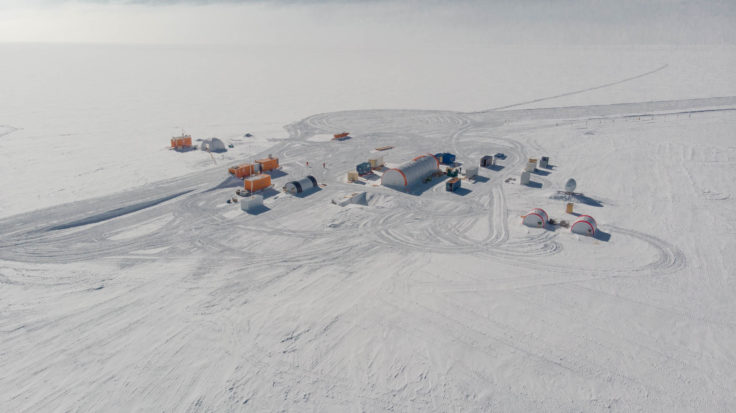Drilling of oldest ice on Earth completed
The first ice core drilling campaign of Beyond Epica-Oldest Ice has been successfully completed at the remote Little Dome C site in Antarctica – one of the most extreme places on Earth. By analysing a deep ice core extracted from the Antarctic ice sheet, scientists aim to find out information on the evolution of the temperatures, on the composition of the atmosphere and on the carbon cycle over the last 1.5 million years.

BAS scientist Dr Robert Mulvaney was part of the site selection team who spent three years looking for the perfect location to extract this ice core. Finally after Covid delays during the 2021/22 campaign, the team completed the field camp installation, set up the drilling area reaching a depth of 130 metres, completed the temporary storage cave, and installed the complex drilling system. The target is to reach a depth of about 2,700 metres, the ice thickness at Little Dome C – an area of 10 km2 located 34 km from the Italian-French Concordia Station.
The campaign is an unprecedented effort in paleoclimatology studies, to reveal invaluable information on temperature and on the concentration of greenhouse gases in the atmosphere in the past. Glaciologists, engineers and technicians of the international team have worked at an altitude of 3,233 metres above sea level, over 1,000 km away from the coast. Strong gusts of wind and a temperature almost always below -40°C, with lows of -52°C, made camp set-up even more challenging.
Carlo Barbante, Director of the Institute of Polar Sciences of the National Research Council of Italy (Cnr-Isp) and professor at Ca’ Foscari University of Venice, is the project coordinator. He says:
“We are very satisfied with the work done so far. Our next campaign will involve a final testing of the drilling system and then speedily proceeding to conduct deep drilling. We believe this ice core will give us information on the climate of the past and on the greenhouse gases that were in the atmosphere during the Mid-Pleistocene Transition (MPT), which happened between 900,000 and 1.2 million years ago. During this transition, climate periodicity between ice ages changed from 41,000 to 100,000 years: the reason why this happened is the mystery we hope to solve.”

The climate and the environmental history of our planet is archived in the ice, which can reveal information from centuries and even hundreds of millennia ago on changing temperatures and on the historical composition of the atmosphere – including levels of greenhouse gases such as methane and carbon dioxide.
Dr Robert Mulvaney, who’s part of the Beyond EPICA project and who was involved in the site selection says:
“I’m delighted that the drilling of the Oldest Ice Core is finally underway. It is almost twenty years now since the first EPICA drilling project reached the bottom of the Antarctic ice sheet at nearly 3200 metres and gave the world the unparalleled record of the evolution of our climate and the greenhouse gases over the past 800,000 years. Now we want to obtain older ice, to understand how our climate and atmosphere changed over 1.5 million years. After three years spent searching for the best site for drilling, we are now at last on our way. Only 130 metres this year, but the drilling camp and the drilling infrastructure is now operational. I am personally looking forward to next season when I will join the drillers to hopefully drill the next 1000 metres on our way to the bedrock.”
This international research project started in 2019 and will last seven years and is funded by the European Commission with 11 million euros, and supported by significant financial and in-kind contributions from the participating nations. The project is coordinated by the Institute of Polar Sciences of the Cnr (National Research Council of Italy).
Other scientists on site were Thomas Stocker, Remo Walther, and Jakob Schwander from the University of Bern. The drillers were Philippe Possenti, Gregory Teste, Olivier Alemany, and Romain Duphil of the University of Grenoble-Alpes, and Matthias Hüther of the Alfred Wegener Institute. Logistics and telecommunications were managed by Michele Scalet, Saverio Panichi, Giacomo Bonanno and Calogero Monaco of Enea, while the electrification of the camp was managed by Olivier Delanoe and Anthony Pauty of the French Polar Institute (Ipev).
Find out more: British Antarctic Survey Beyond Epica and Beyond Epica – Oldest Ice project.